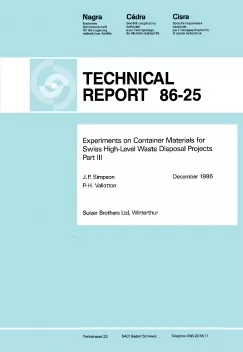
Technical Report NTB 86-25
Experiments on Container Materials for Swiss High-Level Waste Disposal Projects Part III
The present concept for final disposal of high-level waste in Switzerland consists of a repository at a depth of 1000 to 1500 m in the crystalline bedrock of northern Switzerland. The waste will be placed in a container which is required to function as a high integrity barrier for at least 1000 years.
This report is the third in a series dealing with the evaluation of potential materials for such containers. Four materials were identified for further evaluation in the first of these reports; they were cast steel, nodular cast iron, copper and Ti-Code 12. It was concluded that further corrosion testing was needed to confirm these materials as candidate container materials. In the second of these reports it was shown that cast steel possessed sufficient corrosion resistance under repository conditions for it to be considered as the primary candidate material for a high-level waste container. The long term corrosion rate was estimated to be 20 μm/a.
The chemical analyses of groundwaters carried out in the course of the Nagra geological programme suggested that the standard water composition used in the first series of corrosion tests with a total dissolved solids content of 3200 mg/l and 0.1 μg/g oxygen was considerably less saline and more oxidising than those to be expected in a swiss high-level repository (total dissolved solids typically 15000 mg/l and virtually oxygen free).
Immersion tests were carried out in both waters at 80 and 140°C with two levels of oxygen, zero and 0.1 μg/g. The corrosion of cast steel as well as nodular cast iron under all conditions tested was uniform. It was observed that the corrosion rate was greater in the higher salinity water and at the higher oxygen level. The effect of temperature was not so marked. 6000 hour exposure corrosion rates observed were as high as 60 μm/a for cast steel in Böttstein water with 0.1 μg/g oxygen at 80°C and 31 μm/a at 140°C. The oxygen will be quickly consumed (e.g. by the corrosion reaction itself) and anaerobic conditions will predominate shortly after closure. The relevant long term data are therefore the zero oxygen results which range from 4 μm/a in Säckingen water at 140°C to 18 μm/a in Böttstein water at 140°C.
Long term corrosion tests were also carried out in water saturated highly compacted sodium bentonite at 80 and 140°C; under conditions which approximate the conditions in the proposed repository. The corrosion rates for cast steel at 6000 h exposure time were in the range 4-13 μm/a.
Pitting was not observed on the corrosion coupons in the immersion or bentonite tests. Nevertheless, it could be that variations in the groundwater chemistry would lead to severe pitting in particular in the early stages when sufficient oxygen is present. The effects of variations on the main components of the groundwater, i.e. chloride and sulphate, and the role of carbonate, were investigated. Pitting requires a degree of passivity of the rest of the surface for deep pits to grow. Electrochemical measurements showed that passivity was possible at the temperatures tested (50 and 80°C). The most important factors are chloride, carbonate and pH. Carbonate and high pH values promote passivity but high chloride levels although they promote pitting also decrease the passive range so their effect can be to increase or decrease the tendency for pitting depending on the levels of the other two parameters. The electrochemical investigation confirmed the observation that pitting should not occur in the two reference waters.
The 6000 hour corrosion rates from both the immersion testing and in bentonite were below the long term estimate of 20 μm/a assumed for cast steel in the repository for oxygen free conditions. This is the relevant condition for the bulk of the life of the container. There is thus no reason to doubt that this estimate of the overall long term corrosion rate is conservative.
